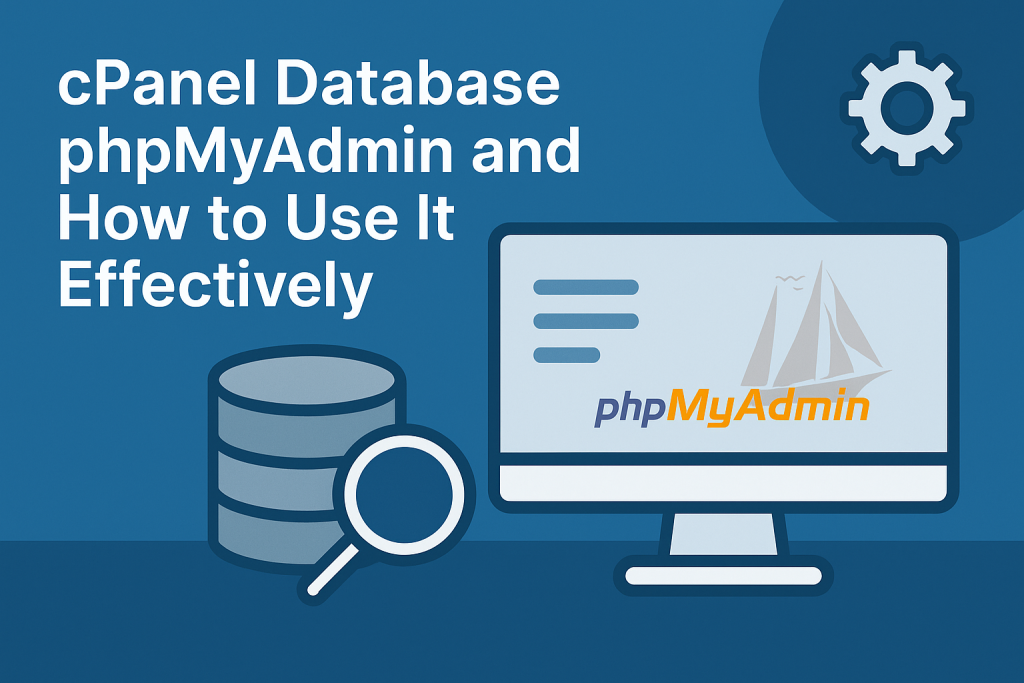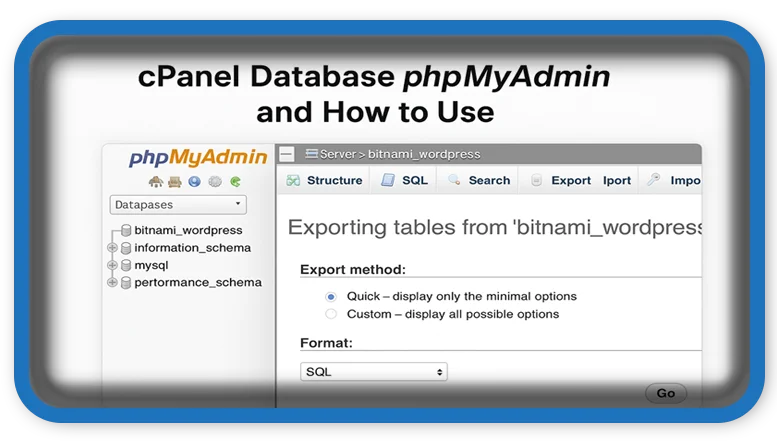⏲️ Estimated reading time: 6 min
cPanel Database phpMyAdmin and How to Use It Effectively
Managing your website’s database is a crucial part of maintaining a healthy, functional web presence. If you’re using cPanel, one of the most widely used hosting control panels, you’re likely already familiar with phpMyAdmin, a powerful tool for managing MySQL databases through a graphical interface. In this guide, we’ll take an in-depth look at what phpMyAdmin is, how it integrates with cPanel, and how you can use it to perform essential database tasks.
What is phpMyAdmin?
phpMyAdmin is an open-source web-based application designed to manage MySQL or MariaDB databases. It allows users to execute SQL queries, manage databases and tables, import/export data, and perform other administrative operations all from a user-friendly interface without needing to use the command line.
It’s especially beneficial for beginners and non-developers who want to access and manage their database without deep technical knowledge.
Why Use phpMyAdmin in cPanel?
Most hosting providers that use cPanel include phpMyAdmin by default, making it extremely easy to access and use. Here’s why phpMyAdmin is a go-to tool:
- User-friendly interface
- Full database access without command line
- Ability to manage multiple databases
- Support for importing and exporting SQL files
- Run SQL queries directly
- Repair and optimize tables easily
Whether you’re running a WordPress blog, an eCommerce site, or a custom-built application, phpMyAdmin can help you keep your database in top shape.
How to Access phpMyAdmin in cPanel
Getting started with phpMyAdmin in cPanel is straightforward. Follow these steps:
- Log in to your cPanel account.
You can typically access cPanel by visitingyourdomain.com/cpanel. - Find the ‘Databases’ section.
Once logged in, look for the phpMyAdmin icon under the Databases category. - Click on phpMyAdmin.
This will redirect you to the phpMyAdmin interface in a new browser tab or window. - Select a Database.
In the left-hand sidebar, you’ll see a list of available databases. Click on the one you want to manage.
Understanding the phpMyAdmin Interface
The phpMyAdmin dashboard may seem overwhelming at first, but it’s organized in a logical way. Here’s a quick overview:
Left Sidebar
This displays the list of all databases available under your hosting account. Clicking on a database will expand to show its tables.
Top Menu Tabs
Once a database is selected, you’ll see tabs like:
- Structure – View and manage tables.
- SQL – Run SQL commands.
- Search – Search through your database.
- Insert – Add new rows of data.
- Export – Download the database or specific tables.
- Import – Upload SQL files to the database.
- Operations – Perform actions like renaming, copying, or deleting the database.
Common Tasks You Can Perform Using phpMyAdmin
1. Creating a New Database
Note: It’s recommended to create databases from the MySQL Databases section in cPanel, not phpMyAdmin. However, phpMyAdmin allows viewing and managing them afterward.
2. Importing a Database
If you’re migrating a site or restoring a backup, here’s how to import a database:
- Click on the target database name.
- Go to the Import tab.
- Click Choose File and select your
.sqlfile. - Click Go to upload and import.
3. Exporting a Database
To create a backup or transfer data:
- Select the database.
- Go to the Export tab.
- Choose Quick or Custom export.
- Click Go to download the
.sqlfile.

4. Running SQL Queries
You can manually run SQL statements:
- Select your database.
- Go to the SQL tab.
- Enter your query (e.g.,
SELECT * FROM users;). - Click Go to execute.
5. Editing Data in Tables
You can manually add, delete, or update records:
- Select a table.
- Go to the Browse tab to view data.
- Use Edit, Delete, or Insert options for changes.
6. Repairing or Optimizing Tables
If your site becomes slow or you suspect database corruption:
- Select the database.
- Check the box next to one or more tables.
- At the bottom, choose Repair table or Optimize table from the drop-down menu.
phpMyAdmin for WordPress Users
If you’re managing a WordPress site, phpMyAdmin is especially useful. You can:
- Reset admin passwords manually
- Change site URLs directly in the database
- Delete spam comments quickly
- Clean up plugin data that wasn’t removed properly
Example: Reset WordPress password via SQL
UPDATE wp_users SET user_pass = MD5('newpassword123') WHERE user_login = 'admin';
⚠️ Always make a full backup before editing anything in your WordPress database!
Best Practices When Using phpMyAdmin
To avoid accidental data loss or corruption, keep these best practices in mind:
- Always back up before making changes.
- Avoid editing or deleting tables you don’t understand.
- Limit access to phpMyAdmin. Enable IP blocking or strong cPanel login credentials.
- Use the Export feature regularly to safeguard your site data.
- Work with a staging site when testing SQL queries.

Troubleshooting Common phpMyAdmin Issues
1. Timeout Errors During Import
This usually happens with large databases. Solutions:
- Split your SQL file into smaller parts
- Use command line import via SSH if available
- Increase upload size limits via
.htaccessorphp.ini
2. Access Denied
Check:
- Are you logged into the correct cPanel account?
- Does the database user have privileges?
- Have you deleted the user associated with the database?
3. Blank Screen or 500 Error
This might relate to memory limits. Try increasing the PHP memory limit or contact your host.
Alternatives to phpMyAdmin
While phpMyAdmin is popular, other tools exist:
- Adminer – Lightweight, single-file interface
- HeidiSQL – Desktop client for Windows
- MySQL Workbench – Advanced GUI client for developers
Each has its pros and cons, but phpMyAdmin remains the most accessible and integrated with cPanel.
Conclusion
phpMyAdmin is a robust and essential tool for anyone managing a website using a MySQL database. Integrated directly into cPanel, it gives you full access to your databases through a user-friendly interface. Whether you’re importing backups, troubleshooting a WordPress site, or optimizing performance, phpMyAdmin offers the flexibility and power to get the job done without touching a terminal.
Just remember: with great power comes great responsibility. Always back up your data, double-check your queries, and never edit your database unless you’re confident about what you’re doing.
📩 Do you have questions or suggestions? Leave a comment or contact us!
🏷️ Tags: cPanel, phpMyAdmin, database management, MySQL, WordPress, SQL queries, web hosting, website backup, import export SQL, phpMyAdmin tutorial
Only logged-in users can submit reports.
Discover more from HelpZone
Subscribe to get the latest posts sent to your email.

